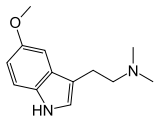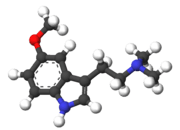5-MeO-DMT
5-MeO-DMT (5-methoxy-N,N-dimethyltryptamine) is a psychedelic of the tryptamine class. It is found in a wide variety of plant species, and at least one toad species, the Sonora Desert toad. Like its close relatives DMT and bufotenin (5-HO-DMT), it has been used as an entheogen in South America.[1]
 | |
 | |
| Clinical data | |
|---|---|
| Routes of administration | Smoked, Insufflated, Oral |
| Legal status | |
| Legal status |
|
| Identifiers | |
IUPAC name
| |
| CAS Number | |
| PubChem CID | |
| IUPHAR/BPS | |
| ChemSpider | |
| UNII | |
| KEGG | |
| ChEBI | |
| ChEMBL | |
| CompTox Dashboard (EPA) | |
| ECHA InfoCard | 100.012.558 |
| Chemical and physical data | |
| Formula | C13H18N2O |
| Molar mass | 218.300 g·mol−1 |
| 3D model (JSmol) | |
SMILES
| |
InChI
| |
| | |
Chemistry
5-MeO-DMT was first synthesized in 1936, and in 1959 it was isolated as one of the psychoactive ingredients of Anadenanthera peregrina seeds used in preparing Yopo snuff. It was once believed to be a major component of the psychoactive effects of the snuff, although this has recently been shown to be unlikely, due to the limited or sometimes even non-existent quantity contained within the seeds, which instead achieve their psychoactivity from the O-demethylated metabolite of 5-MeO-DMT, bufotenin.[2][3] It is metabolized mainly by CYP2D6.[3]
Religious use
5-MeO-DMT is a sacrament of the Church of the Tree of Life. From approximately 1971 to the late 1980s, 5-MeO-DMT was discreetly available to its members.[4] Between 1970 and 1990 smoking of 5-MeO-DMT on parsley was probably one of the two most common forms of ingestion in the United States.[4]
Pharmacology
5-MeO-DMT is a methoxylated derivative of DMT. Based on studies in rats, its pharmacological activity is believed to be mainly through serotonin receptors. Specifically, it shows high affinity for the 5-HT2 and 5-HT1A subtypes.[5] Additional mechanisms of action such as inhibition of monoamine reuptake may be involved also.[6]
Legal status
China
As of October 2015, 5-MeO-DMT is a controlled substance in China.[7]
Australia
As a structural analog of N,N-dimethyltryptamine (DMT), 5-MeO-DMT is a Schedule 9 prohibited substance under the Poisons Standard.[8]
Sweden
Sveriges riksdags health ministry Statens folkhälsoinstitut classified 5-MeO-DMT, listed as 5-metoxi-N,N-dimetyltryptamin (5-MeO-DMT) in their regulation SFS 2004:696, as "health hazard" under the act Lagen om förbud mot vissa hälsofarliga varor (translated Act on the Prohibition of Certain Goods Dangerous to Health) in October 2004, making it illegal to sell or possess.[9]
Turkey
5-MeO-DMT has been controlled in Turkey since December 2013.[10]
United States
5-MeO-DMT was made a Schedule I controlled substance in January 2011.[11]
See also
- 4-MeO-DMT
- 5-MeO-AMT
- 5-MeO-DIPT
- 5-EtO-DMT
- Dimemebfe
- List of entheogens
References
- Araújo AM, Carvalho F, Bastos M, Guedes de Pinho P, Carvalho M (August 2015). "The hallucinogenic world of tryptamines: an updated review". Archives of Toxicology. 89 (8): 1151–73. doi:10.1007/s00204-015-1513-x. PMID 25877327.
- Ott J (July–September 2001). "Pharmañopo-psychonautics: human intranasal, sublingual, intrarectal, pulmonary and oral pharmacology of bufotenine". Journal of Psychoactive Drugs. 33 (3): 273–81. doi:10.1080/02791072.2001.10400574. PMID 11718320.
- Shen HW, Jiang XL, Winter JC, Yu AM (October 2010). "Psychedelic 5-methoxy-N,N-dimethyltryptamine: metabolism, pharmacokinetics, drug interactions, and pharmacological actions". Current Drug Metabolism. 11 (8): 659–66. doi:10.2174/138920010794233495. PMC 3028383. PMID 20942780.
- "5-MeO-DMT Timeline". Erowid.
- Krebs-Thomson K, Ruiz EM, Masten V, Buell M, Geyer MA (December 2006). "The roles of 5-HT1A and 5-HT2 receptors in the effects of 5-MeO-DMT on locomotor activity and prepulse inhibition in rats". Psychopharmacology. 189 (3): 319–29. doi:10.1007/s00213-006-0566-1. PMID 17013638.
- Nagai F, Nonaka R, Satoh Hisashi Kamimura K (March 2007). "The effects of non-medically used psychoactive drugs on monoamine neurotransmission in rat brain". European Journal of Pharmacology. 559 (2–3): 132–7. doi:10.1016/j.ejphar.2006.11.075. PMID 17223101.
- "关于印发《非药用类麻醉药品和精神药品列管办法》的通知" (in Chinese). China Food and Drug Administration. 27 September 2015. Retrieved 1 October 2015.
- "Poisons Standard July 2016". Federal Register of Legislation.
- "Förordning om ändring i förordningen (1999:58) om förbud mot vissa hälsofarliga varor" (PDF). Svensk författningssamling (in Swedish). 7 September 2004.
- "Turkish Law" (PDF). Resmi Gazete. 16 December 2013.
- Drug Enforcement Administration (DEA), Department of Justice (December 2010). "Schedules of controlled substances: placement of 5-methoxy-N,N-dimethyltryptamine into Schedule I of the Controlled Substances Act. Final rule" (PDF). Federal Register. 75 (243): 79296–300. PMID 21171485.